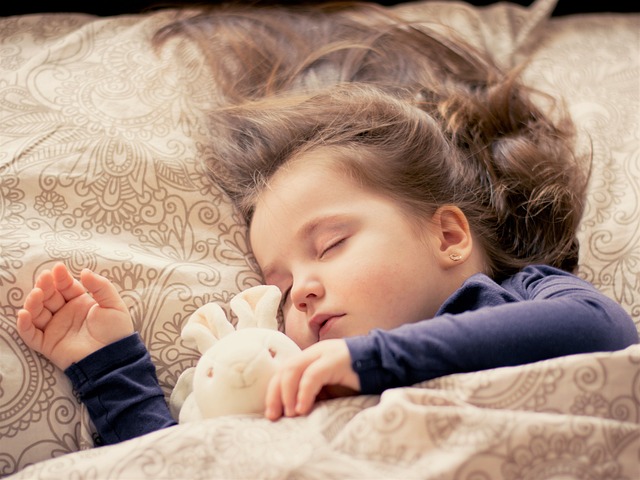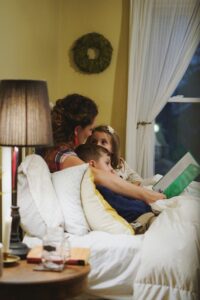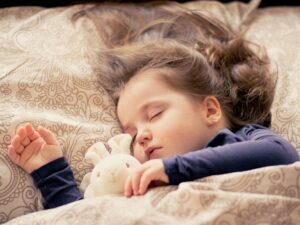September 2024

Knowing how to best support your child’s sleep can be difficult. Babies don’t come into the world having the capability to put themselves to sleep, and so we quickly learn as parents it is our task to create and maintain routines and practices that usher them into a healthy sleep life. As they get older and more engaged in the world, new challenges arise and these practices must respond to their changing consciousness and needs. A framework of rhythm, routine and ritual is a great start, but we must consider more than that. We have to look at the whole day’s rhythms and activity, to observe our child’s behavior and habits, and consider what stimulations may be standing in their way to a healthy night of sleep.
Helpful Rhythms
In general, an evening rhythm should have the gesture that the whole house is settling down. For the couple of hours before bed, activity slows down and provides a framework for sleep to come. Silence isn’t necessary (and may even be unhelpful), but activity winds down, lights are dim, talk is quiet. This type of rhythm may begin after a lengthy bout of robust play, and be very consistent from day to day so that it is the rhythm that begins cueing the body into sleep.
A few extra tips to consider as you construct this rhythm:
- Start early. There’s an important window of time to make when children are ready for sleep. “When our children (and us) stay up late at night we affect the liver’s metabolism.

It can no longer simply store sugar. Our body, by being awake and active, needs sugar in the bloodstream and so we force the liver to reverse its process and breakdown glycogen to provide this sugar. We get a second wind, a burst of sugar in our blood stream, and yet we are really depleting our energy for the next day.” 1
- “If sleep is a struggle, designate bedrooms as “sleep only” spaces. Move toys to a corner of the kitchen or living room and declutter bedrooms. Read bedtime stories in the living room and move to the bedroom when it’s time for sleep.” 2
- “Once you’ve decided on a rhythm, resolve to stick to it for bedtimes. Just as you convey to your child that you will hold hands while crossing a busy street, you need the same kind of resolve regarding bedtime. Without that resolve, your child will sense the “wiggle room” and resist your efforts.” 2
A Body that Welcomes Sleep
In the larger picture of your child’s sleep life it’s important to consider the relationships between their body, soul and spirit~ or physical body, emotional body and intellect.
Having a harmonious relationship between these bodies means that they are all functioning in rhythm, and that your child is experiencing their full capacity for self-awareness. Harmony between bodies is crucial for healthy sleep patterns. Rudolf Steiner described how a portion of the soul and the spirit are “breathed out” of the body at night and return to the body upon waking. A lack of consciousness (awareness) or arrhythmic activity during the day indicates that these bodies aren’t coming back into right relationship with each other.
Oversensitivity, over-irritability, hyperactivity, under activity, inability to retain information, and hyperfixation are all well-known symptoms of lack of sleep, but also demonstrations of disharmony among these bodies. They are simple descriptions of what Steiner called the curative polarities. A vicious cycle develops when children (or we) chronically lack good sleep, in which the struggle for full consciousness and consonant rhythms interferes with getting the sleep we need for well being.

Ensuring that your child’s day is full of healthy, robust play and deliberate activity helps these bodies function in right relationship. Healthy play means that children are engaged in purposeful storylines and games. A good example of unhealthy play is when children are running around without aim, often literally in circles, and constantly bellowing or growling.
With practice, you can tell a subtle difference between a good play, and when your child begins to unravel or “spin out.” At this point they need to be redirected to something else or into a healthier form of play. This kind of “spin out” indicates excarnation (losing self-awareness), and makes it very difficult for them to learn how to regulate themselves and practice a healthy use of will. Self-awareness (or consciousness) is absolutely necessary for children to direct their will appropriately into meaningful play and work. And you can support the development of the will by involving your child in purposeful activities for their own care and around the home.
About Bedtime Stories
Many routines include bedtime stories as a way to connect and settle children down for sleep. Stories also fill them with beautiful imagery, ripe for dreaming. It’s helpful when the stories you
 create or select are filled with soothing content that continues the mood you have been working to cultivate. Creating stories takes practice, but has an incredible effect upon children, especially when the mood you radiate is soothing and peaceful.
create or select are filled with soothing content that continues the mood you have been working to cultivate. Creating stories takes practice, but has an incredible effect upon children, especially when the mood you radiate is soothing and peaceful.
Not all children need a bedtime story, however. For the child who is already very “awake” to the world, anxious, or overactive, a story can sometimes be too stimulating. Using body compressions, massages, soothing essential oils or other practices that ease them into their body can be more efficacious for these little ones.
For children five and above, one of these alternatives may help as well. Include a few minutes to engage in one of them, and then follow up with some of these soothing physical experiences.
- “Empty the Pond”~ Within this analogy, our mind is like a pond and the fish are thoughts darting about. A bedtime routine with this image gives children a concrete image to empty their mind of thoughts.
- Review the Day~ In taking stock of what happened during the day, children who are anxious might have the chance to relieve anything that is holding them up from settling down. Talking them through the event and the remainder of the day indicates to them that they made it through, and have no need to carry their worry into the night.
- Picture Journaling~ Shortly before being tucked in, some children find it helpful to draw “story pictures” about their day or something else on their mind. This can be a solitary activity, or something they share with you. Either way, it can have a similar effect of bringing them into a place of stillness of mind.
Electronics and Sleep Music or White Noise
Digital stories and sleep music come in handy sometimes within busy family life, but consistent use of them can actually be more stimulating than settling, and have long-term negative consequences. Consider this:
“For the young child, the skin is a tremendous sense organ. It is the gateway to all of their senses. Their experience of warmth, touch and love, comes firstly through their skin and their sense of touch. Imagine all the tiny hairs on a child’s body, vibrating rapidly to the EMFs of the devices that surround her.
Now imagine how this impacts the child’s long term sense of well being. Just as the cilia of the cochlea become inured to the constant onslaught of sounds in a factory, so too, our children become numb to the harmonious soothing of the human heart and more attuned to the EMFs of technology.” (2)
A state of constant stimulation (such as with electronic stories or music that children fall asleep to) bodes poorly for finding peace within natural silence. It also interferes with proper development of balance. Hearing and balance are interconnected. Research demonstrates that not just loud noise, but constant noise for long durations of time damages the inner ear, compromising the vestibular system that is responsible for maintaining balance. As you will read below, strong balance creates positive sleep habits in several ways.
One additional consideration must be made about electronic stories and music~ As children grow older, having devices at their whim (even simple ones like Yoto) often ends up keeping them awake well into the night. And then, you’re back to square one, developing healthy sleep habits after having to undo some negative ones.
Being in Balance- Stillness of Mind
A consistent frustration voiced by children who have trouble sleeping is that they are bored. They may not be filled with thoughts shooting about their minds, but instead, searching for something to think about or do because they are uncomfortable at rest. Unfortunately, it is necessary to push through the eye of the needle on this one. These are often children who are naturally active (or overactive) and do not appreciate having to be still in the first place, but have also not had required periods of rest. They immediately become restless and expectant of something to stimulate them, and then they’re up and begin hassling you.
To support them over this obstacle, activity must be balanced with practiced rest throughout the day, multiple times a day. These periods of rest can be small pauses with a lavender face wash, looking at a book, or a cup of tisane on the couch. Even a moment’s breath several times a day is helpful to let the mind settle before moving on.
It’s ideal to nap through the age of five (and totally possible!), but an extended rest, lying down with nothing else is second best. Frame their extended rest with a couple of brief rituals to set the tone and hold firm boundaries about the expectations.

Movement activities that involve balance also develop stillness of mind. Consider what happens when you close your eyes and put your feet together, or stand on one foot for an extended period of time. Can you do it with a busy mind? No. Instead, our head must be clear and focused on the task of finding balance. When our children (or us) have poor physical balance, it is both due to and affects the ability to have a quiet mind and be at peace with sleep.
Furthermore, the sense of balance also creates a sense of self-continuity. When I move across the room, I know I started as me and I end as me. When I lie down I am me, and when I close my eyes I am still me. Without self-continuity, children experience fear and the restlessness or anxiety that comes from the sympathetic nerve response to that fear. When we practice rest and stillness, peace of mind follows and so does healthier sleep.
![]()
1 Johnson, Susan R. MD, FAAP. “The Importance of Sleep”. Youandyourchildshealth.org
2 Marshall, Diana. “Gentling Your Child Into Sleep,” Chapter from “A Year With the Rosies”.


